Calendula salve is one of the best homemade skin care remedies to have on hand. It is simple to make and has powerful benefits for the skin. It is gentle enough for the whole family to use, yet highly effective! Learn how to make this homemade calendula salve for dry skin, rashes, bug bites, minor cuts, scrapes, and burns.
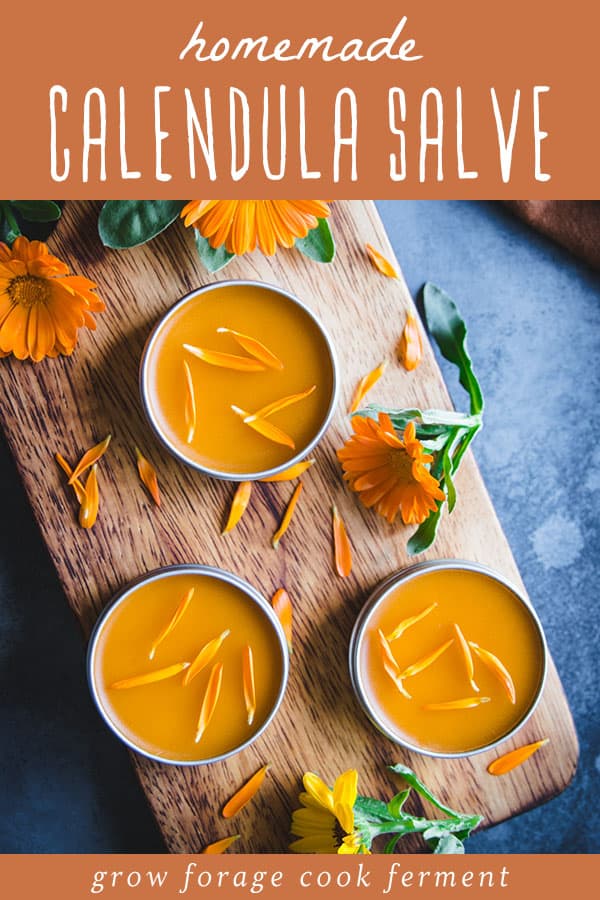
Calendula Benefits
Calendula officinalis is a beautiful orange flower that has powerful anti-inflammatory and wound healing benefits. It is also anti-viral, anti-fungal, anti-microbial, and astringent.
Due to all of these properties combined, calendula is one of the best plants that you can use to make an herbal salve! It is a favorite herb of many herbalists for this reason.
You can also use calendula flowers in creams, lotions bars, and soaps.
Calendula is easy to grow and one of the best herbs to have in your garden!
Learn more about growing and using calendula in this post: 10 Reasons to Grow Calendula for your Garden, Food, and Health.
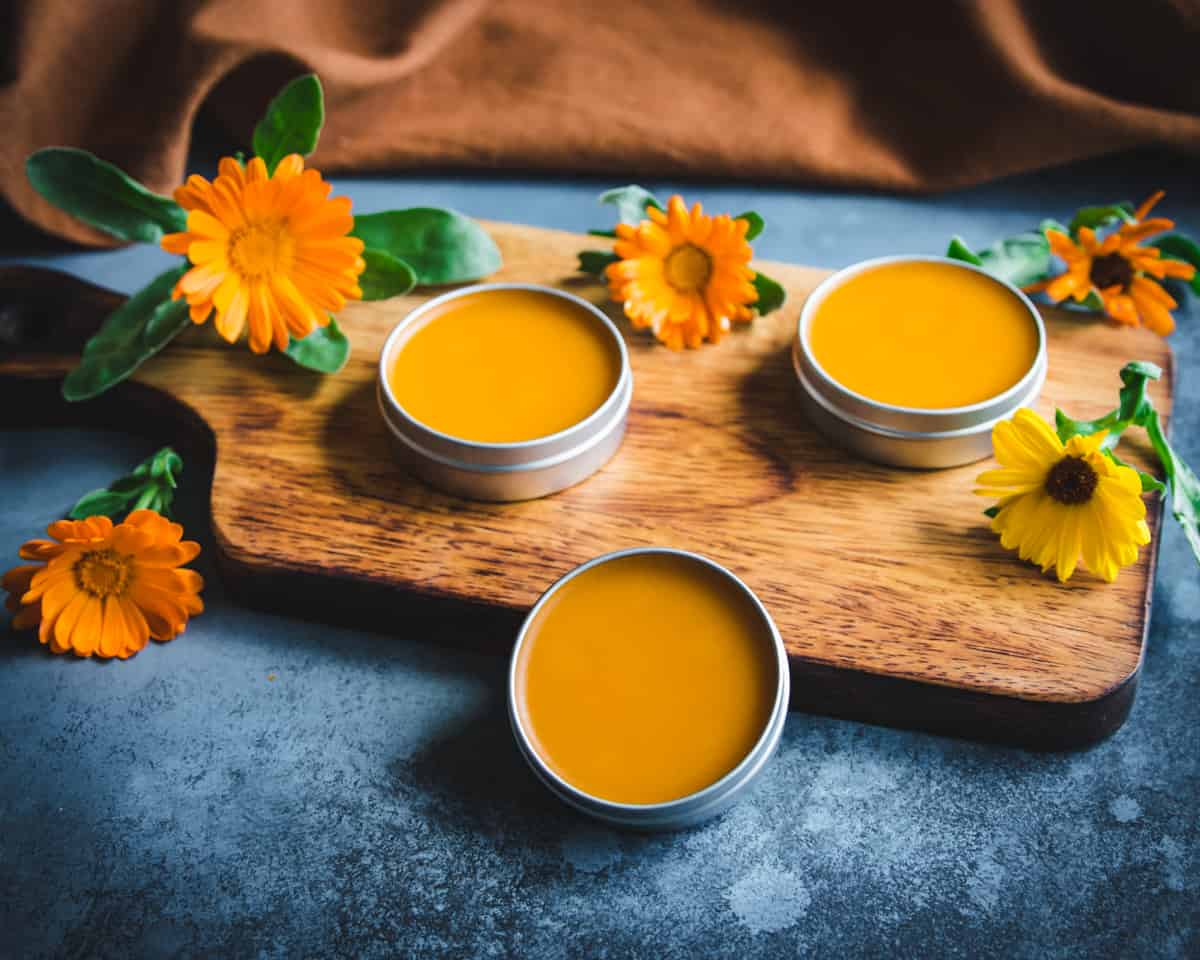
How to Make Calendula Salve
Homemade calendula salve is one of the easiest herbal remedies to make. I always make sure that I have some on hand, as we go through quite a bit of it!
Make the Calendula Infused Oil
The first step to making this salve is to make calendula infused oil.
It is best to use dried calendula flowers when making the infused oil. If you are growing your own calendula you can easily dry them on homemade drying screens.
If you don’t have access to calendula flowers, you can buy dried calendula from Mountain Rose Herbs.
When making the calendula infused oil, first think about how much salve you would like to make. Since we go through so much, and since I also use calendula oil for other things as well, I tend to use a quart jar.
If you only need a smaller batch of salve a pint or half-pint jar of calendula oil may be all that you need.
Put the dried calendula flowers into the jar about 3/4 of the way full. Then fill the jar with a carrier oil (or a blend of oils) of your choice.
Olive oil is a great choice as a carrier oil and is easy to find. I often use a blend of about 50% olive oil, 25% melted coconut oil, and 25% sweet almond oil. Each oil has its own benefits and it’s really up to you which one you’d like to use.
Cap the jar with a lid and let the oil infuse for 4-6 weeks (or more) in a cool spot out of direct sunlight.
You can alternatively use the quick method for making infused oils by heating the oil and dried flowers in a pot on low heat for up to 12 hours, but the infused oil may not be as potent.
Related: 10 Ways to Use Calendula Infused Herbal Oil
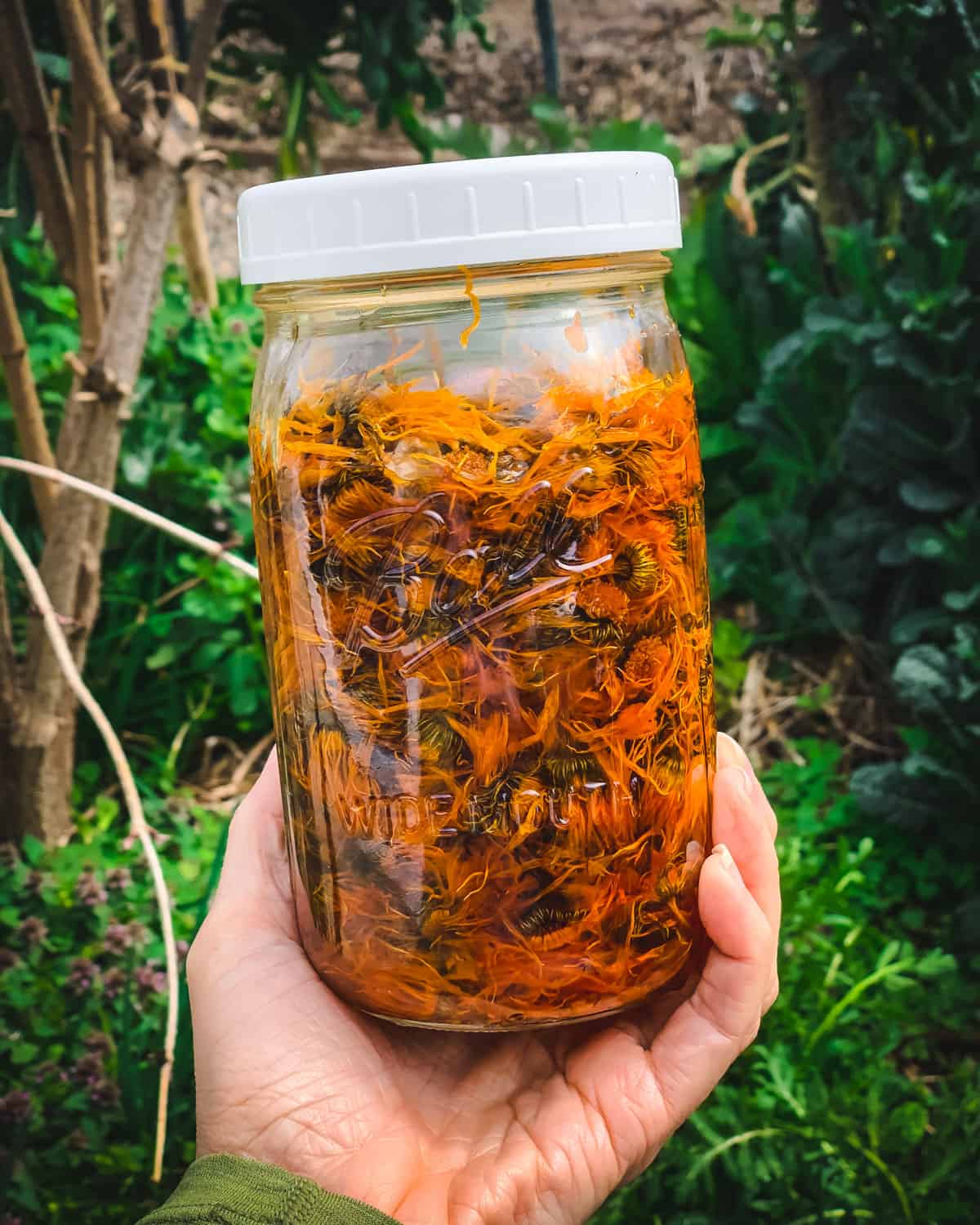
Make the Calendula Salve
Once the calendula oil has infused, strain out the flowers from the oil with a fine mesh sieve lined with cheesecloth.
Squeeze the oil out of the calendula flowers in the cheesecloth to get all of that wonderful calendula oil. The oil will be a nice golden or maybe even a gorgeous orange color!
This oil I made had been infusing for several months using homegrown and dried calendula flowers. It was such a deep orange color and smelled amazing!
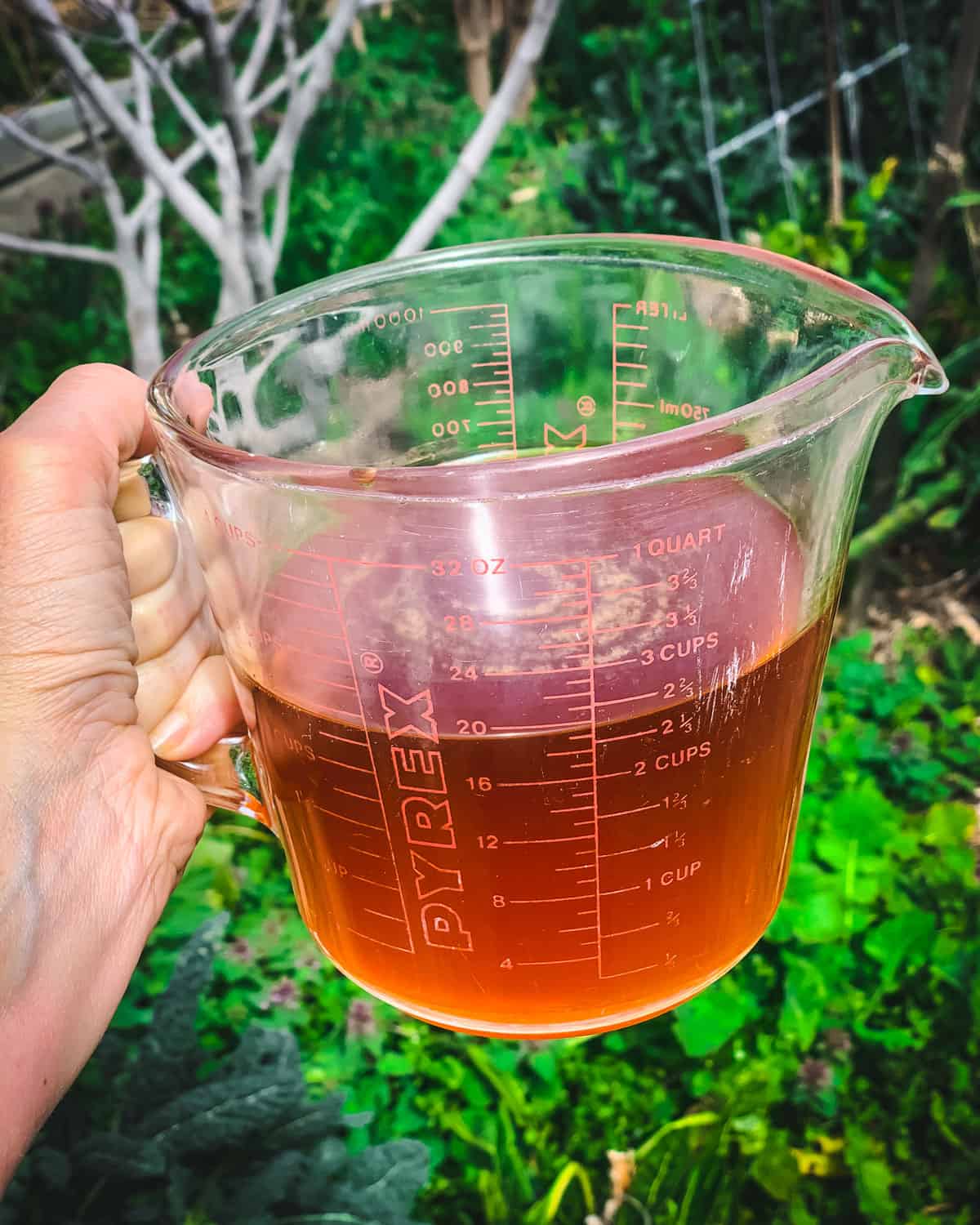
Heat the oil in a double boiler on your stove. You can create a makeshift double boiler by putting a small bowl or a glass Pyrex measuring cup over a pot with about an inch of simmering water.
Add the beeswax and stir occasionally (a wooden or bamboo skewer or chopstick works well for this) until the beeswax completely dissolves into the oil.
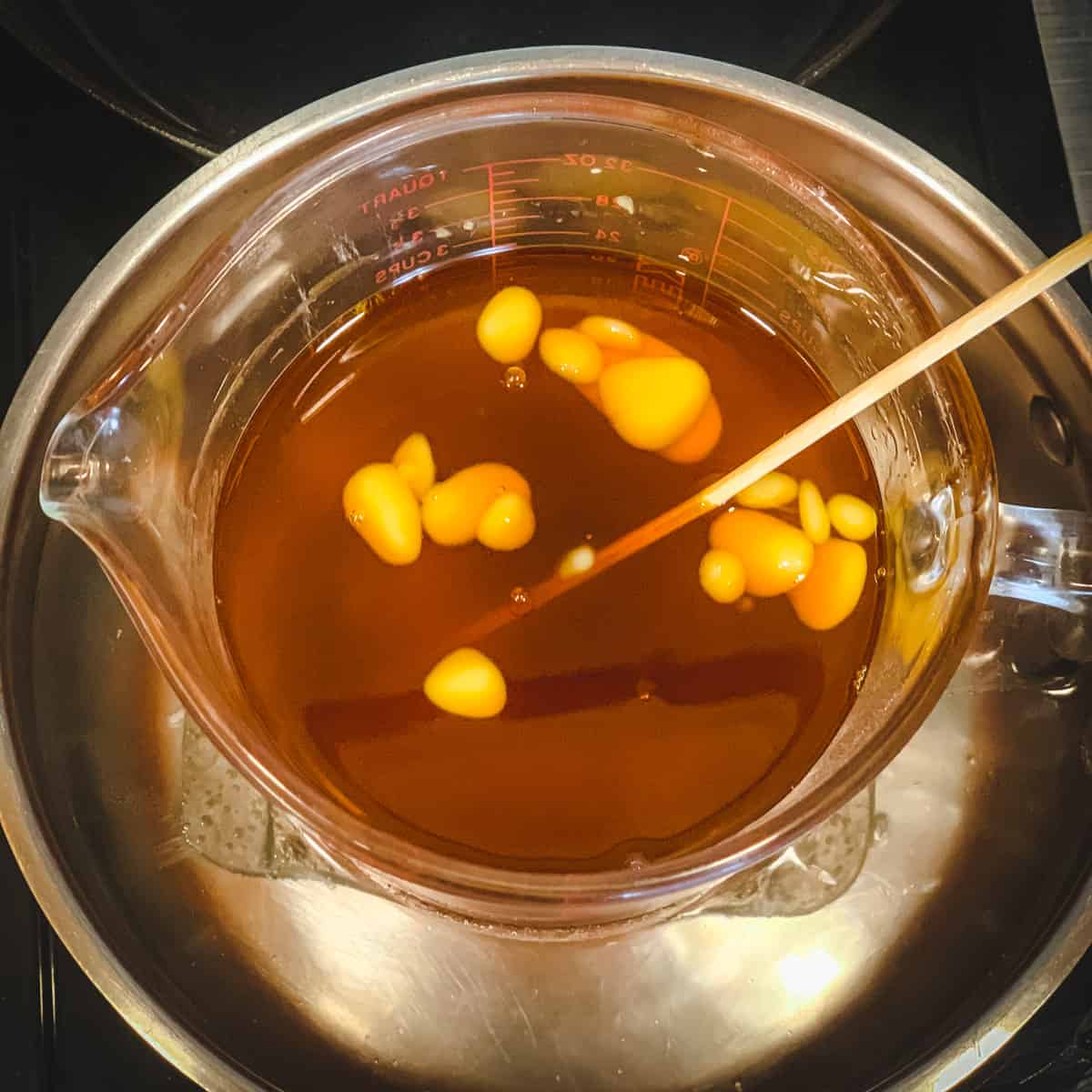
Then remove the oil/beeswax mixture from the heat and add in the optional shea butter, stirring quickly and constantly until it melts. This will make the salve a bit richer if you choose to use it.
Pour the salve mixture into tins or jars.
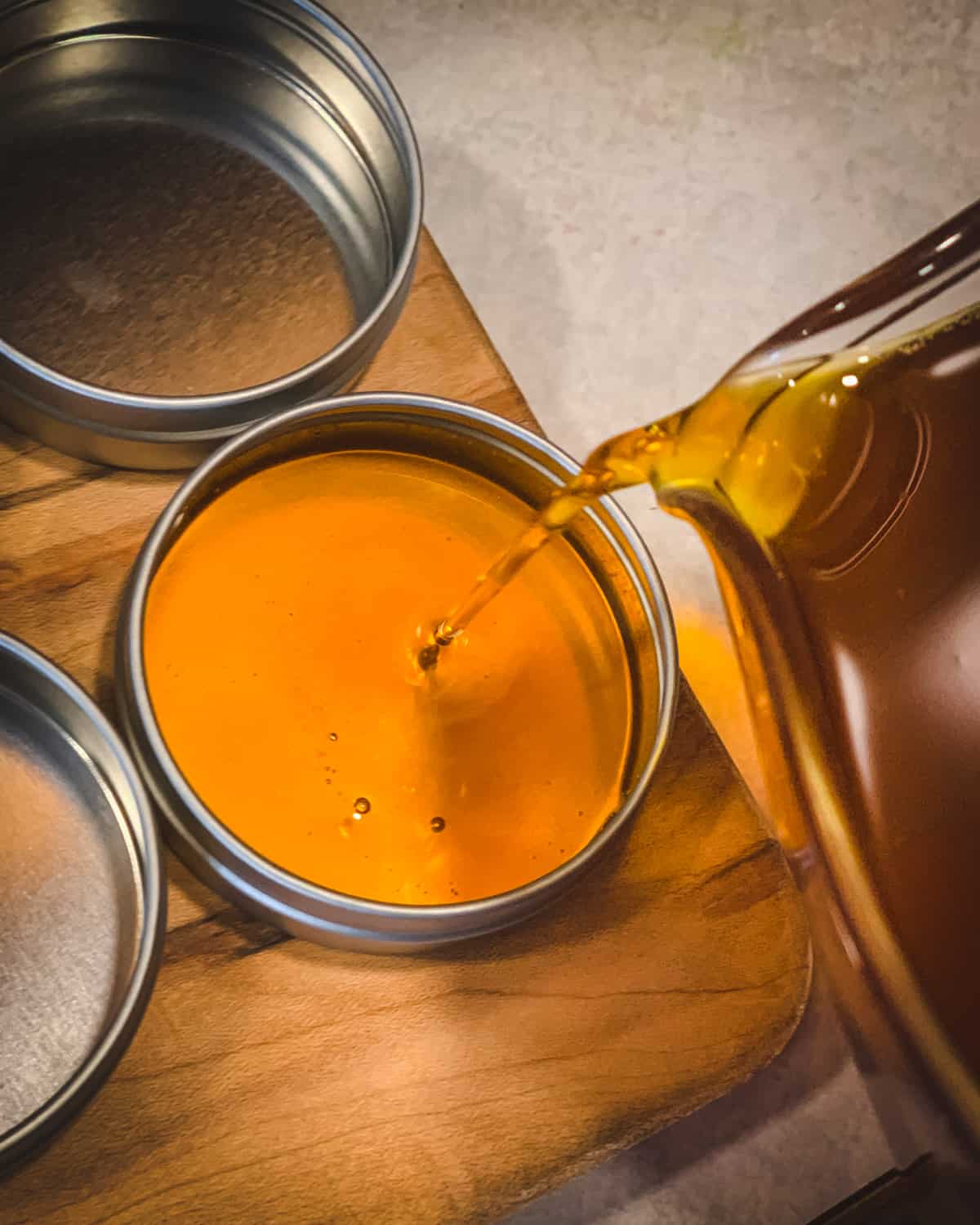
Let the salve set up for several hours or until it is completely cooled before using.
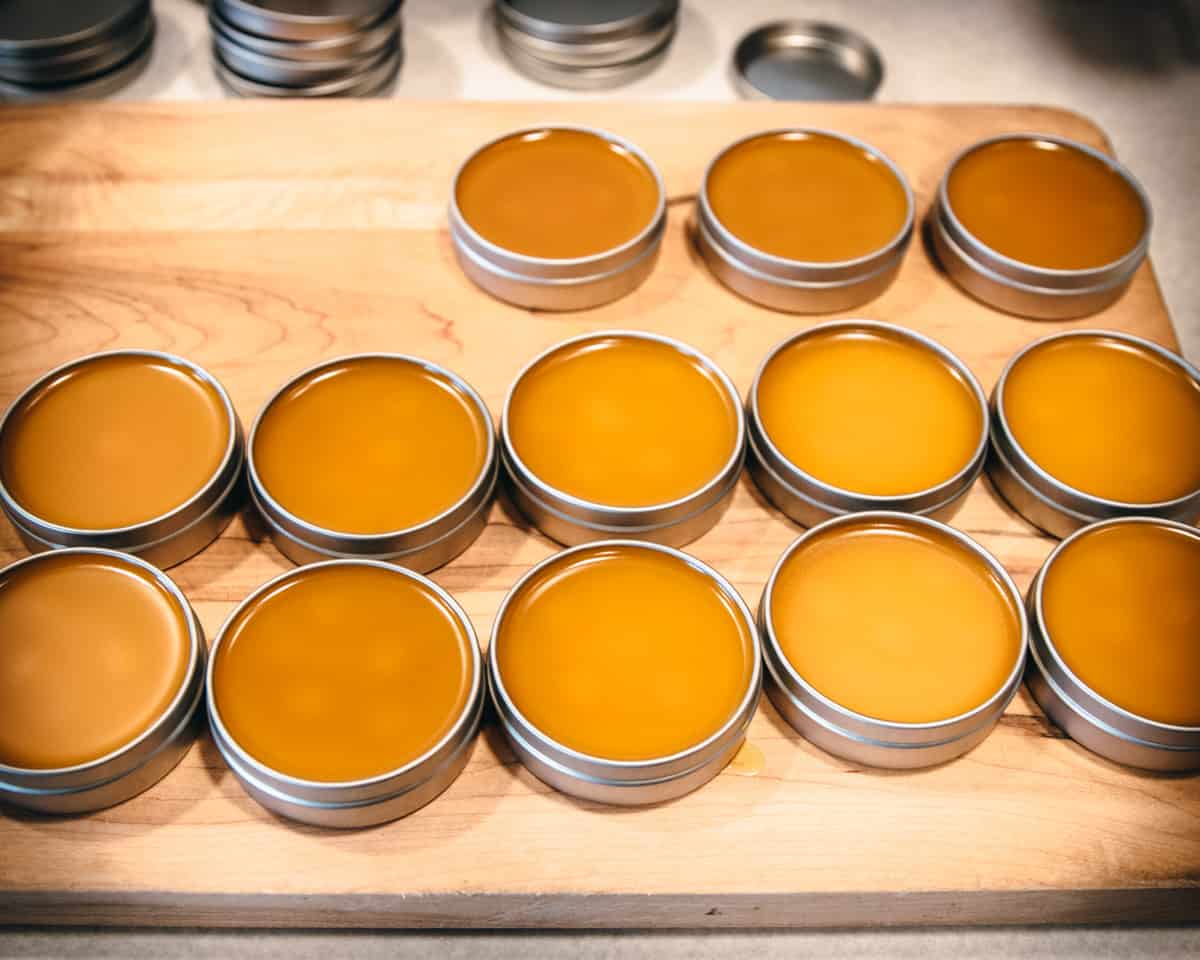
After the salve is fully set you will have an amazing herbal skincare remedy!
This salve will last for a year or more if kept in a dry place out of intense heat and sunlight.
Not only is this calendula salve wonderful for all different kinds of skin ailments, but it is also beautiful. Definitely, one of my favorite salves to make for many reasons!
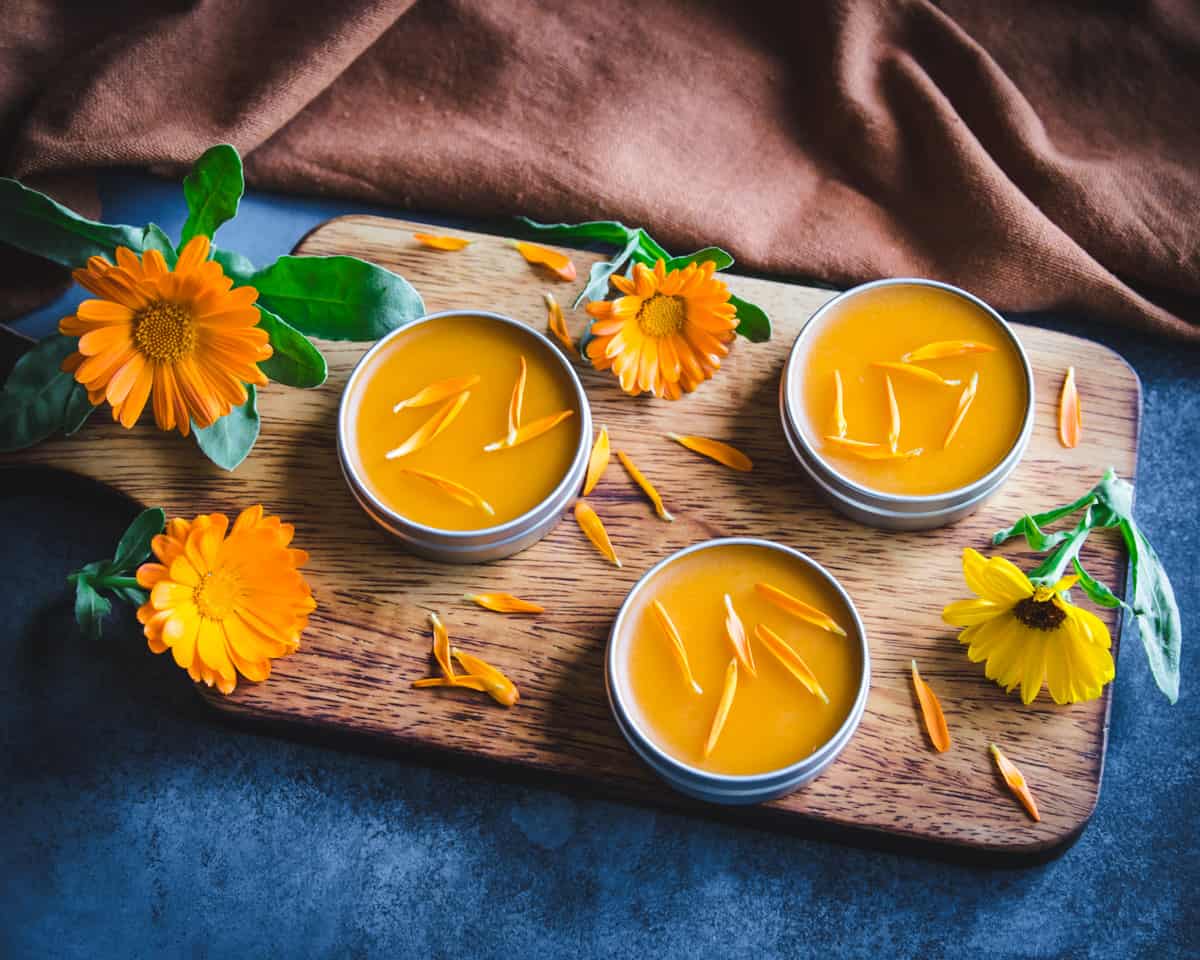
How to Use Calendula Salve
Calendula salve is most commonly used on dry skin, rashes, bug bites, minor cuts, scrapes, scars, and burns. It may also be effective in relieving eczema, especially when combined with plantain.
Calendula salve is very gentle on the skin and can be used by the whole family, even on babies and small children. It works well for diaper rash and any small boo-boos that may happen.
(See my herbal diaper rash salve post for an even better recipe that also uses calendula!)
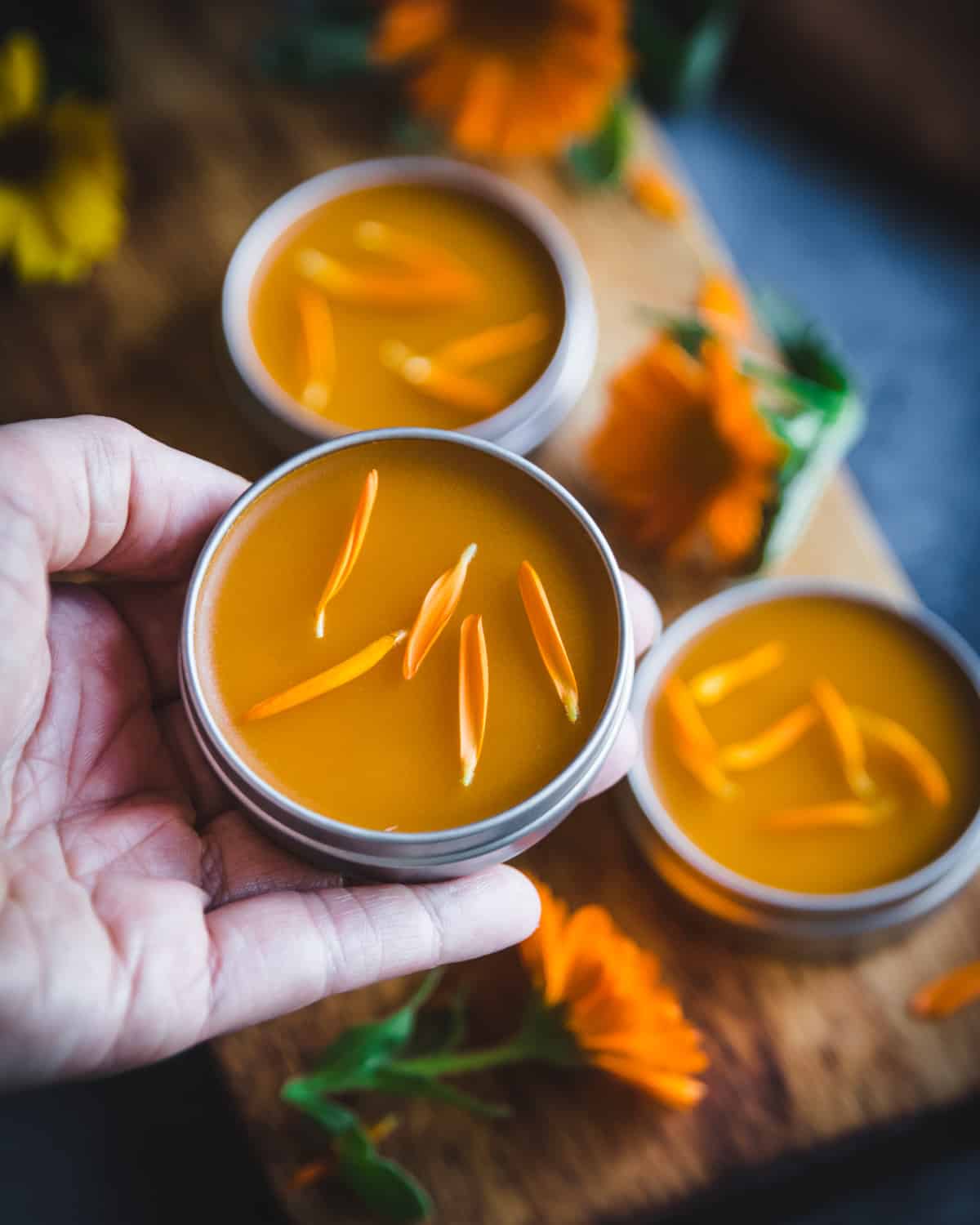
Rub a little bit of calendula salve on any skin ailment and it is sure to help. We use it almost daily in our household. It is perfect for my dry skin and my 4 year old loves using it whenever he can.
It is the perfect herbal remedy!
Want more herbal salve recipes? here are 10 for you to include in your natural skin care routine!
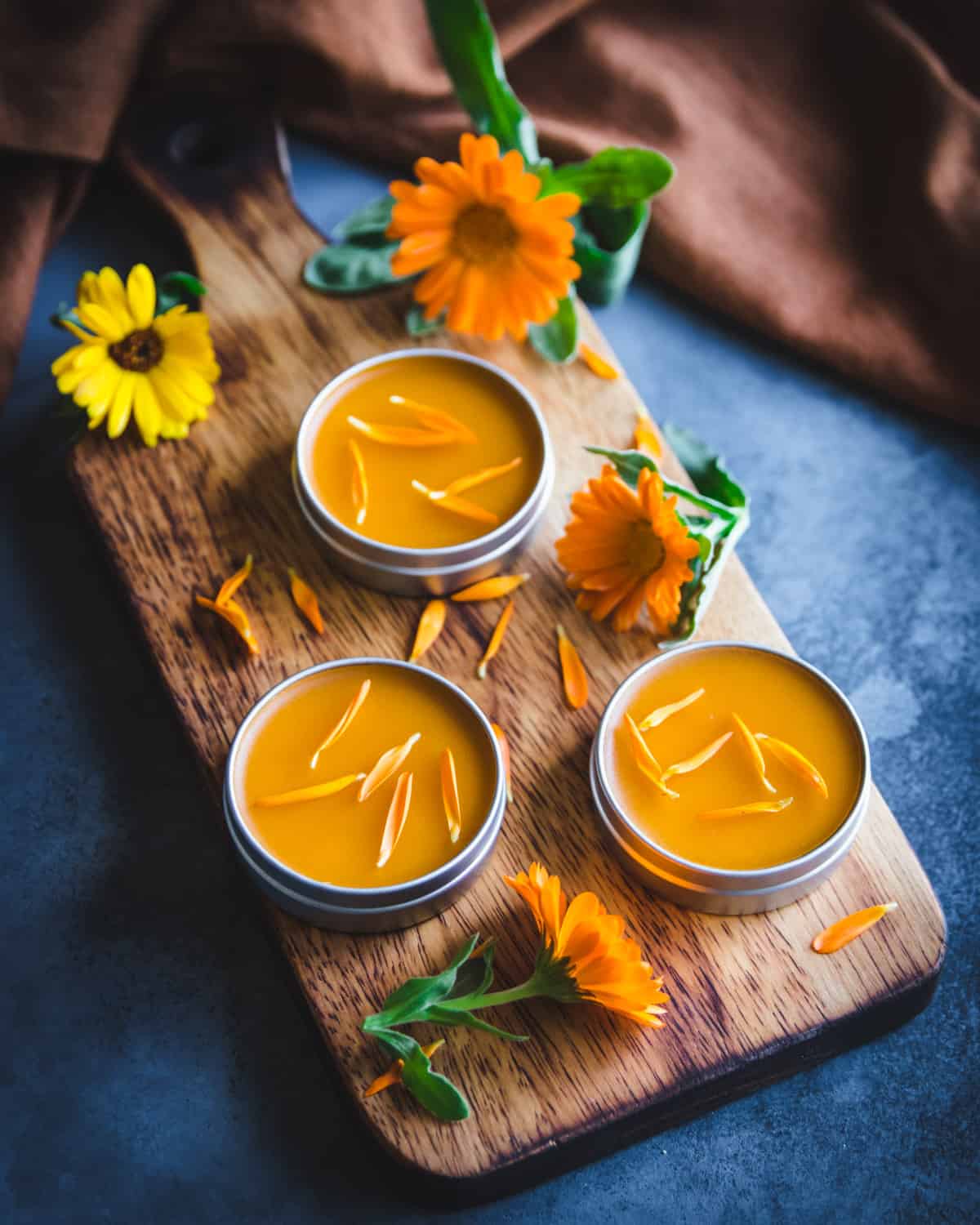
More Calendula Recipes
Here are more ways to use calendula flowers – they are even edible!
- 10 Ways to Use Calendula Herb Infused Oil
- Calendula Lotion Bars
- Calendula Cream
- Diaper Rash Salve
- Calendula Soap
- Herbal Bath Salt with Calendula
- Homemade Calendula Lip Balm
- Whipped Body Butter with Calendula
- Calendula Shortbread Cookies
- Calendula Iced Tea
- Pine Salve
Homemade Calendula Salve
Equipment
Ingredients
Calendula Infused Oil
- 1 cup dried calendula flowers
- 1 1/2 cups carrier oil I like to use a blend of olive oil, melted coconut oil, and sweet almond oil
Calendula Salve
- 1 cup calendula infused oil
- 1 ounce beeswax
- 1 ounce refined shea butter optional
Instructions
Calendula Infused Oil
- Put the dried calendula flowers into the jar about 3/4 of the way full. Then fill the jar with a carrier oil (or a blend of oils) of your choice.
- Cap the jar with a lid and let the oil infuse for 4-6 weeks (or more) in a cool spot out of direct sunlight.
- Once the calendula oil has infused, strain out the flowers from the oil with a fine mesh sieve lined with cheesecloth. Squeeze the remaining oil out of the flowers in the cheesecloth.
Calendula Salve
- Heat the calendula infused oil in a double boiler on your stove. You can create a makeshift double boiler by putting a small bowl or a glass Pyrex measuring cup over a pot with about an inch of simmering water.
- Add the beeswax and stir occasionally (a wooden or bamboo skewer or chopstick works well for this) until the beeswax completely dissolves into the oil.
- Then remove the oil/beeswax mixture from the heat and add in the optional shea butter, stirring quickly and constantly until it melts.
- Pour the salve mixture into tins or jars.
- Let the salve set up for several hours or until it is completely cooled before using.
Notes
- This calendula salve recipe is easily adapted to smaller or larger batches. Simply double it for a larger batch or cut it in half for a smaller batch.
- Olive oil is a great choice as a carrier oil and is easy to find. I often use a blend of about 50% olive oil, 25% coconut oil, and 25% sweet almond oil. Each oil has its own benefits and it’s really up to you which one you’d like to use.
- You can alternatively use the quick method for making infused oils by heating the oil and dried flowers in a pot on low heat for up to 12 hours, but the infused oil may not be as potent.
- This salve will last for a year or more if kept in a dry place out of intense heat and sunlight.

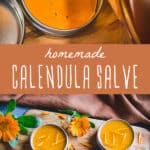
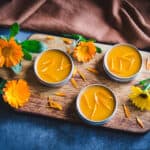

I made this salve yesterday. This morning it is still not hardened but mostly liquid. Did something go wrong? Is their a way to fix it?
That is really strange. If you used beeswax, it should have become solid. Are you somewhere warm and humid? I would try putting them in the fridge to see if that solidifies them.
my granddaughter gave me a jar of calendula salve 2 years ago and i havent used it. do i rub it on my skin? do i wash it off?
You rub it on your skin. It doesn’t need to be washed off.
I am new to this field and have a few questions.
How many two ounce containers will this recipe make.
How do I figure how to make say ten or twenty tins.
Thank you
The recipe makes 12 ounces, so it depends on the size of the tins you buy. If you buy 1 ounce tins, you need 12.
Great idea. I’m about to try this with ilipe nut butter.
Hi! Love this idea and can’t wait to try. My calendula flowers are yellow…does that sound right? They look just like your orange ones. I’m also growing marigolds which are sort of similar I know. Feel free to email me if that’s easier!
Hi Becca. Yes, calendula flowers can also be yellow!
What a great simple recipe! This is my first time making a salve. infusion is done, just wondering what this is supposed to smell like? Mine smells not great? I’ve have it infusing since July 2 – so just shy of 8 weeks, and used your mixture of olive oil, almond oil, and coconut oil. Would you suggest maybe mixing in some essential oils to help it be more yummy smelling? Lol
Of course, you can add whatever fragrance you prefer.
Would this be okay to use on your face? Could the oil alone be good on your face?
Hi Stephanie. I personally wouldn’t use it on my face as coconut oil is comedogenic and may clog pores (it’s best for body use). You could try replacing the coconut oil in this recipe with jojoba oil or another carrier oil with a low comedogenic rating.
Is the olive oil used as carrier oil same as the one we use in cooking or different?
Yes, it’s the same, but I would be sure to use a high-quality olive oil.
Hi, I’m really wanting to make this as I have stacks of calendula growing in my garden and already use store bought calendula cream for bug bites and itchy skin. A few questions, do you dry and infuse the whole flower or just the petals? Second, how do you go about cleaning your saucepans, jugs etc. that have had the melted wax in them? That’s probably the biggest thing putting me off making my own salves. Do you keep separate equipment to make your salves, or do you just use your regular food cooking equipment? Thanks!
Hi Melanie. Yes, I use the whole flower when using them for salves and creams. To answer your second question, I reheat my stainless steel bowl until the wax melts and remove it with a spatula. Any remaining leftover wax comes off with ease under hot running water. All the ingredients in my herbal salves are food-safe, (otherwise I wouldn’t put them on my skin!) so there’s really no reason to have separate equipment but if you’d like to, go for it.
Hi Melanie, I’m just making this recipe and saw your question. When I’ve struggled to get the melted wax off equipment I use cheap vodka and a cloth to wipe it – this is a tip I got from someone else, it dissolves the wax so you can remove any excess, before finishing with hot water and soap. Works a treat!
If someone wants to experiment, they can have a medicinal preparation even without beeswax. Only one or more oils can be used and used for the same purpose. So just macerate and done. This is done only when we lack beeswax and we need it as soon as possible. 12% beeswax is usually added to the macerate. For hard balm add 13 or 14%.
This balm is great, if you have too much balm it is good to put a preservative to extend the shelf life as needed. But it is best to do the balm every year and not let it stand for too long. Thank you.
Can I use the calendula leaves for a salve? It’s the end of the growing season, and I still have lots of plants, but no more flowers.
Thanks.
Yes, you can use the leaves.
Ok I’ve heard that comfrey is toxic yet I see a lot of ppl still using it.. thoughts?
Comfrey contains pyrrolizidine alkaloids that can be harmful to the liver if ingested.
However, comfrey in a salve applied to unbroken skin is not likely to be a problem.
If I would like to use calendula and comfrey infused oil to make a salve. Can I infuse the herbs in my crockpot directly on low and for how long? Also would equal amounts of dried flowers and comfrey be ok? Is it better to sun infuse even though it takes weeks?
I wanted to make the salve for my dog with skin issues. I was thinking of infusing in olive oil and then adding in Shea and coconut. I’m not sure if the beeswax would be ok. My salve doesn’t have to be completely solid. So many questions sorry! It will be my first time doing this! How long can I leave it out of the fridge?
Thanks so much, Jo
Hi Jo, yes you can infuse the herbs in crockpot, usually around 8 hours on very low heat is good. Equal amounts of the herbs is perfect, and it’s up to you if you want to sun infuse or not. If you don’t add beeswax or another wax then the salve would be very liquid, unless you used only coconut oil. Even then in the heat of the summer it would liquefy. I recommend using beeswax, and it doesn’t need to stay in the fridge at all. Hope that helps!
I love the fact that you gave me a new utility to this flower I have been planting in my vegetable garden for 11 years now with the only use of adding some color and to attract insects! I have a question about making the calendula oil… I read the procedures and it says to leave the oil infused with flower in an sunny window for weeks. I kinda forgot mine for 12 weeks… is it too long? Did the oil turn bad already?
Thank you very much!
It’s hard to say, but you will know by smelling it if it has gone rancid!
Hi. I just made your salve recipe. Decided to halve it since I’m learning. I used organic calendula oil and sweet almond oil that I purchased from Mountain Rose Herbs. Love their products. Added tea tree and lemongrass oils. Added extra beeswax since it’s so hot and humid here in Alabama. The salve turned out lovely! Thank you for a wonderful recipe!
Do you have any suggestions for someone who can’t use beeswax? Any advice would be appreciated!
You could try carnauba wax, but I’ve never used it so I’m not sure what the end results would be. You can see different wax options from Mountain Rose Herbs.
Would coconut oil work instead of wax?
You could definitely use coconut oil as part or all of the oil portion in the recipe, but it won’t work to set up the salve like beeswax does. If you don’t want to use beeswax, you can try carnauba wax (vegan) in it’s place. Shea butter might also work to a lesser degree.
as much as beeswax and carnuba wax sound good. Carnauba may not be a sustainable option (Derived from Palm), and Beeswax is not vegan.
However, would shea butter mixed with coconut oil could work Or coconut oil and olive oil?
The salve will not set up as much without some kind of wax added. Candelilla wax is another vegan and palm free alternative. Again, I haven’t used it so I’m not sure of how much you would want to use as a replacement for beeswax.
Emulsifying wax?
0
We are mid autumn in Australia, so the growing of calendulas and nasturtiums will be a forward plan. Love the idea of making my own salve. Bought some Comfrey cream yesterday, now that would be a good project too. Enjoy your spring/summer. We are enjoying not having to water plants this season. All the best.